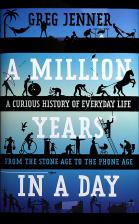Food for Thought: A History of Everyday Eating Habits
June 21, 2016
2 minute read
A Million Years in a Day: A History of Everyday Life by Greg Jenner explores the origins of our daily routines in a range of areas, spanning fashion to food, and from a range of time periods, extending back to the Stone Age.
Journey through the history of food with these ten fun facts from Greg Jenner’s newest book:
- In times of famine, the Aztecs chewed spiders, ant eggs, deer manure, and soil. In medieval China there were at least 400 so-called “famine foods,” including tree bark and grassy herbs.
- Breakfast cereal was first devised in the 1800s by Dr. Kellogg, who was looking for a food that might reduce the human desire to masturbate.
- Humans only started drinking animal milk 7,500 years ago, during the Neolithic Agricultural Revolution. This dietary change is so recent that only 30% of people have the mutated gene to consume it without incurring flatulence.
- The Romans loved bacon, but were suspicious of sausages, seeing them as a barbarian’s food. They were even outlawed in the 4th century C.E. Greek philosopher Socrates worried that they were more pooch than pig.
- The tin can was invented for a competition conducted by the French government in the 1790s. Oddly, it was another 48 years before the can opener was invented.
- Curries were eaten as early as 4,000 years ago by the Bronze Age Harappans.
- Spices like pepper were known as “black gold” in Roman times, and a desire to speed up the journey to spice-producing India was a major impetus for Christopher Columbus’ 1492 voyage. In fact, it was Columbus who’s responsible for the term “chili pepper,” after mistaking chili for pepper.
- The discovery of the New World introduced lots of foods now considered staples, including chili, turkeys, potatoes, tomatoes, and corn.
- In Europe, potatoes were thought to cause flatulence and leprosy, and even peasants dying of starvation refused to eat them, until a 1770s campaign by frenchman Antoine-Augustin Parmentier revived their image.
- In the 19th century, it was very fashionable to eat white bread, but also very expensive. A black market of bakers began selling fake white bread, made to look lighter by adding alum, bone, arsenic, or chalk into brown bread, often causing the eater serious indigestion or worse.







